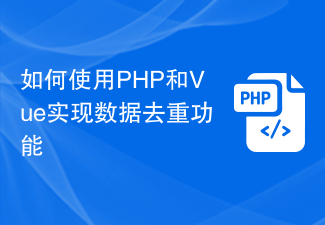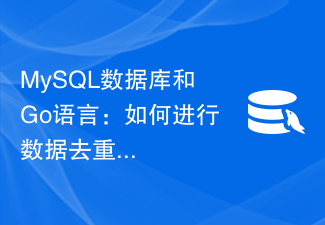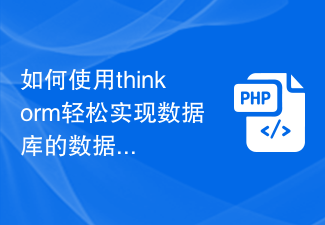 Backend Development
Backend Development PHP Tutorial
PHP Tutorial How to use thinkorm to easily achieve data deduplication and deduplication in the database
How to use thinkorm to easily achieve data deduplication and deduplication in the databaseHow to use ThinkORM to easily achieve data deduplication and deduplication in the database
Overview:
When developing applications, we often encounter duplicate data in the database. Data deduplication and data update are very common operations. In order to simplify this process, we can use ThinkORM, a simple and powerful ORM toolkit, to implement data deduplication and update in the database.
ThinkORM is an ORM toolkit based on PHP language. It provides powerful database operation functions and supports a variety of databases, including MySQL, SQLite, PostgreSQL, etc. Through ThinkORM, we can easily operate the database and realize the addition, deletion, modification and query of data.
This article will introduce how to use ThinkORM to achieve data deduplication and update in the database. We will use the MySQL database as an example and provide corresponding code examples.
Step 1: Install ThinkORM
First, we need to install ThinkORM in the project. You can install it through Composer, just run the following command:
composer require topthink/think-orm
Step 2: Configure database connection information
After the installation is completed, you need to configure the database connection. Add the following code to the project configuration file (usually config/database.php):
return [
// 默认数据库连接
'default' => 'mysql',
// 数据库连接信息
'connections' => [
'mysql' => [
// 数据库类型
'type' => 'mysql',
// 主机地址
'hostname' => '127.0.0.1',
// 用户名
'username' => 'root',
// 密码
'password' => '123456',
// 数据库名
'database' => 'test',
// 数据库编码默认采用utf8mb4
'charset' => 'utf8mb4',
// 数据库表前缀
'prefix' => '',
// 数据库调试模式
'debug' => true,
],
],
];Modify the above parameters according to the actual situation, including database type, host address, user name, password, database name, etc.
Step 3: Create a model object
In ThinkORM, operate the database by creating a model object. First, we need to create a model class. Create a new class named User in the project and inherit the thinkModel class. This class will automatically associate the users table.
namespace appmodel;
use thinkModel;
class User extends Model
{
// 设置主键字段名
protected $pk = 'id';
}In the model class, we can set some properties, such as primary key field name, data table name, etc.
Step 4: Data deduplication
Below we will introduce how to use ThinkORM to achieve data deduplication. Suppose we have a table named user with duplicate name data in it. We need to remove duplicate name data and keep only one copy.
// 导入模型类
use appmodelUser;
// 查询所有用户数据
$users = User::field('username')->group('username')->havingRaw('COUNT(*) > 1')->select();
// 循环遍历重复的用户数据
foreach ($users as $user) {
// 查询同名用户数据
$duplicateUsers = User::where('username', $user['username'])->select();
// 获取最新的重复用户数据
$latestUser = $duplicateUsers->order('create_time desc')->find();
// 删除除最新数据外的其他重复数据
User::where('username', $user['username'])->where('id', '<>', $latestUser['id'])->delete();
}The above code implements the deduplication operation on duplicate name data in the user table. First, we use the field method to specify the query field, the group method to group based on the username field, and the havingRaw method to filter out duplicates data. Next, we traverse the repeated user data through a loop. In each loop, we use the where method to query the user data with the same name, and use the order method according to the create_time field. Sort in descending order to get the latest duplicate user data. Finally, delete duplicate data except the latest data through the delete method.
Step 5: Data update
In addition to data deduplication, sometimes we also need to update the data in the database. Below we will introduce how to use ThinkORM to implement the data update function.
// 导入模型类
use appmodelUser;
// 查询需要更新的用户数据
$users = User::where('score', '>', 80)->select();
// 更新数据
foreach ($users as $user) {
// 对score字段进行加1操作
$user->score = $user->score + 1;
$user->save();
}The above code implements the update of user data with scores greater than 80 in the user table. Each update adds 1 to the score field. First, we use the where method to query user data that meets the conditions. Then, we loop through the queried user data. In each loop, we add 1 to the score field and call the save method to save the update.
Summary:
By combining ThinkORM and MySQL database, we can achieve simple and efficient database data deduplication and update functions. Whether we are developing new projects or maintaining existing projects, using ThinkORM can help us easily implement these operations and improve development efficiency. Hope this article is helpful to you!
The above is the detailed content of How to use thinkorm to easily achieve data deduplication and deduplication in the database. For more information, please follow other related articles on the PHP Chinese website!
 React Query 数据库插件:实现数据去重和去噪的方式Sep 27, 2023 pm 03:30 PM
React Query 数据库插件:实现数据去重和去噪的方式Sep 27, 2023 pm 03:30 PMReactQuery是一款强大的数据管理库,它提供了许多用于处理数据的功能和特性。在使用ReactQuery进行数据管理时,我们经常会遇到一些需要进行数据去重和去噪的场景。为了解决这些问题,我们可以使用ReactQuery的数据库插件,通过特定的方式来实现数据去重和去噪的功能。在ReactQuery中,使用数据库插件可以方便地对数据进行
 PHP开发技巧:如何实现数据去重和去重复功能Sep 22, 2023 am 09:52 AM
PHP开发技巧:如何实现数据去重和去重复功能Sep 22, 2023 am 09:52 AMPHP开发技巧:如何实现数据去重和去重复功能在实际开发中,我们经常会遇到需要对数据集合进行去重或去重复的情况。无论是对于数据库中的数据,还是对于来自外部数据源的数据,都可能存在重复的记录。本篇文章将介绍一些PHP开发技巧,帮助开发者实现数据去重和去重复的功能。一、基于数组的数据去重如果数据是以数组形式存在的,我们可以使用array_unique()函数来实现
 如何使用PHP和Vue实现数据去重功能Sep 25, 2023 am 10:24 AM
如何使用PHP和Vue实现数据去重功能Sep 25, 2023 am 10:24 AM如何使用PHP和Vue实现数据去重功能引言:在日常的开发过程中,经常会遇到需要对大量数据进行去重的情况。本文将介绍如何使用PHP和Vue实现数据去拓的功能,并提供具体的代码示例。一、使用PHP进行数据去重要使用PHP进行数据去重,通常可以利用数组的键名唯一性来实现。以下是一个简单的示例代码:<?php$data=array(1,2,2,3,
 MySQL数据库和Go语言:如何进行数据去重?Jun 17, 2023 pm 05:49 PM
MySQL数据库和Go语言:如何进行数据去重?Jun 17, 2023 pm 05:49 PMMySQL数据库和Go语言:如何进行数据去重?在实际的开发工作中,很多时候需要对数据进行去重处理,以确保数据的唯一性和正确性。本文将介绍如何使用MySQL数据库和Go语言进行数据去重,并提供相应的示例代码。一、使用MySQL数据库进行数据去重MySQL数据库是一种流行的关系型数据库管理系统,在数据去重方面有着很好的支持。下面介绍两种利用MySQL数据库进行数
 如何使用 PHP 实现数据去重和重复项处理功能Sep 05, 2023 am 09:12 AM
如何使用 PHP 实现数据去重和重复项处理功能Sep 05, 2023 am 09:12 AM如何使用PHP实现数据去重和重复项处理功能在开发Web应用程序时,经常需要对数据进行去重和重复项处理,以确保数据的唯一性和准确性。PHP是一种广泛使用的服务器端编程语言,它提供了丰富的函数和库,可以帮助我们实现这样的功能。本文将介绍如何使用PHP实现数据去重和重复项处理功能。一、使用数组实现数据去重PHP的数组是一种非常强大和灵活的数据结构,
 如何处理C++大数据开发中的数据冗余问题?Aug 25, 2023 pm 07:57 PM
如何处理C++大数据开发中的数据冗余问题?Aug 25, 2023 pm 07:57 PM如何处理C++大数据开发中的数据冗余问题?数据冗余是指在开发过程中,多次存储相同或相似的数据,导致数据存储空间浪费,严重影响程序的性能和效率。在大数据开发中,数据冗余问题尤为突出,因此解决数据冗余问题是提高大数据开发效率和降低资源消耗的重要任务。本文将介绍如何使用C++语言来处理大数据开发中的数据冗余问题,并提供相应的代码示例。一、使用指针减少数据复制在处理
 如何处理C++开发中的数据去重问题Aug 21, 2023 pm 11:06 PM
如何处理C++开发中的数据去重问题Aug 21, 2023 pm 11:06 PM如何处理C++开发中的数据去重问题在日常的C++开发过程中,经常会遇到需要处理数据去重的情况。无论是对一个容器中的数据进行去重,还是在多个容器之间进行去重,都需要找到一种高效而可靠的方法。本文将介绍一些常见的数据去重技巧,帮助读者在C++开发中处理数据去重问题。一、排序去重法排序去重法是一种常见且简单的数据去重方法。首先,将待去重的数据存入一个容器中,然后对
 如何使用thinkorm轻松实现数据库的数据去重和去重Jul 29, 2023 pm 04:54 PM
如何使用thinkorm轻松实现数据库的数据去重和去重Jul 29, 2023 pm 04:54 PM如何使用ThinkORM轻松实现数据库的数据去重和去重概述:在开发应用程序时,经常会遇到数据库中存在重复数据的情况。数据去重和数据更新是很常见的操作,为了简化这个过程,我们可以使用ThinkORM这个简单而强大的ORM工具包来实现数据库的数据去重和更新。ThinkORM是一个基于PHP语言的ORM工具包,它提供了强大的数据库操作功能,支持多种数据库,包括My


Hot AI Tools

Undresser.AI Undress
AI-powered app for creating realistic nude photos

AI Clothes Remover
Online AI tool for removing clothes from photos.

Undress AI Tool
Undress images for free

Clothoff.io
AI clothes remover

AI Hentai Generator
Generate AI Hentai for free.

Hot Article

Hot Tools

PhpStorm Mac version
The latest (2018.2.1) professional PHP integrated development tool

SublimeText3 Mac version
God-level code editing software (SublimeText3)

mPDF
mPDF is a PHP library that can generate PDF files from UTF-8 encoded HTML. The original author, Ian Back, wrote mPDF to output PDF files "on the fly" from his website and handle different languages. It is slower than original scripts like HTML2FPDF and produces larger files when using Unicode fonts, but supports CSS styles etc. and has a lot of enhancements. Supports almost all languages, including RTL (Arabic and Hebrew) and CJK (Chinese, Japanese and Korean). Supports nested block-level elements (such as P, DIV),

Notepad++7.3.1
Easy-to-use and free code editor

Safe Exam Browser
Safe Exam Browser is a secure browser environment for taking online exams securely. This software turns any computer into a secure workstation. It controls access to any utility and prevents students from using unauthorized resources.





